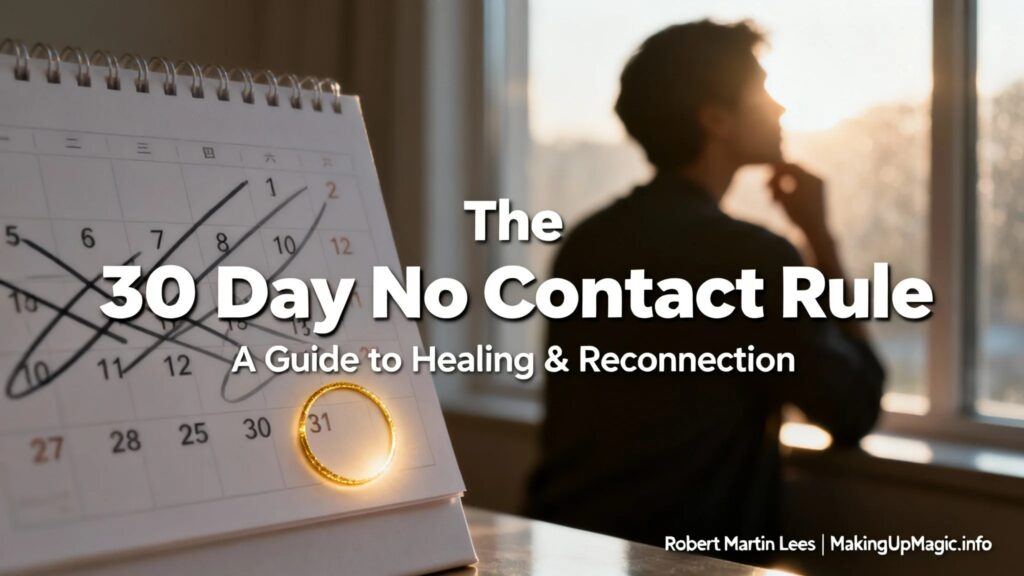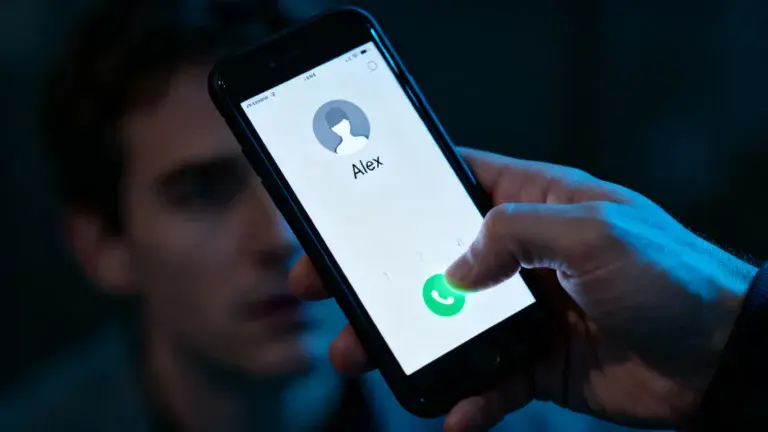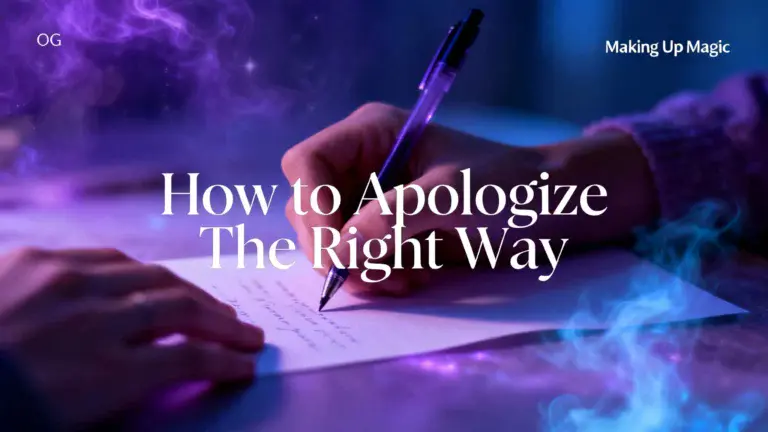t’s the first piece of advice everyone gives you, right? “Just do ‘no contact’.”
It sounds so simple. A magic 30-day reset button. But when you’re on day three, staring at your phone, feeling that raw, physical urge to just check their profile… it feels less like a strategy and more like self-torture. You have to wonder: Does this actually work, or am I just delaying the inevitable pain?
I’ve been in that exact spot. I treated the 30-day mark like a finish line, believing that if I could just make it, everything would magically fix itself. Sometimes it helped. Other times, it was a complete disaster.
What I’ve learned since—from my own journey and from coaching thousands of others—is this: The No Contact Rule isn’t about the number of days. It’s about what you do with the silence. It’s not a trick to manipulate your ex into coming back; it’s the most powerful tool you have to win yourself back. And ironically, that’s the only thing that truly makes them reconsider.
This isn’t just another list of rules. This is the definitive guide to how it works, why it works, and the day-by-day journey you’re about to go on.
What No Contact *Really* Is: An Emotional Detox
At its core, the No Contact Rule is a commitment to cut off all communication with your ex for a set period, typically 30 days. This is non-negotiable:
- No texting or calling them.
- No replying if they reach out (with rare exceptions for true emergencies or shared logistics).
- No engaging with their social media. No liking, no commenting, and for God’s sake, no viewing their stories. You’re not a ghost; you’re gone.
- No asking mutual friends about them.
The goal isn’t to punish them. It’s to break the cycle of emotional dependency. After a breakup, you’re in withdrawal from a drug—the drug of validation, routine, and connection. Constant contact is like taking tiny hits, keeping the addiction alive and the wound infected. No contact is the detox. It’s the only way to let the wound heal cleanly.
 The Psychology: Why Silence Is So Damn Powerful
The Psychology: Why Silence Is So Damn Powerful
This isn’t magic; it’s psychology. Silence works by flipping three powerful switches in the human brain.
- Pattern Interrupt: Your relationship had a rhythm. After the breakup, that rhythm is replaced by an obsessive pattern of checking, re-reading old texts, and seeking validation. No contact is a hard stop. It forcibly breaks this loop, giving your brain the space to stop panicking and start forming new, healthier neural pathways.
- Psychological Reactance: It’s human nature. When something is taken away, we want it more. By removing your presence, you shift the entire power dynamic. Your ex goes from feeling pressured, annoyed, or certain of your availability to suddenly experiencing your absence. This void creates curiosity, which often blossoms into respect and longing. They can’t miss you if you’re never gone.
- Emotional Regulation: You can’t heal a cut you keep poking. Every text, every story view, is you poking the wound. The 30 days of silence act as an emotional cleanse, allowing the intense, reactive feelings of hurt and anxiety to subside. Clarity only comes when the emotional storm has passed.
The 30-Day Journey: What to Expect Week by Week
 Week 1 (Days 1-7): The Storm
Week 1 (Days 1-7): The Storm
This is hell. Let’s not sugarcoat it. The anxiety will be high, the cravings to reach out will be intense. You’ll feel phantom phone vibrations. You’ll draft a dozen texts and delete them. This is the withdrawal phase. Your only job this week is to survive. Don’t focus on self-improvement yet. Just focus on breathing. Mute them, archive their chat, and tell a friend to hold you accountable. Feel the feelings; don’t numb them. If you need to cry, cry. This is the poison leaving your system.
Week 2 (Days 8-14): The Fog Lifts
The raw, electric pain starts to fade into a dull ache. You’ll sleep a little better. You might go a full hour without thinking about them. This is where you can start introducing small, positive habits. A 15-minute walk. Journaling. Reconnecting with one friend. You’ll start seeing the relationship with more clarity, noticing the cracks you ignored before. A crucial sign it’s working: you stop blaming yourself for everything.
Week 3 (Days 15-21): The Power Shift
This is when things get interesting. You’re starting to feel like yourself again. You’re not just surviving; you’re building a life you actually enjoy. And a funny thing happens when your focus shifts from them to you: their focus often shifts back to you. This is when you might see the first “bread crumb”—a story view, a random like, a text from a mutual friend “just checking in.” Your silence has created a vacuum, and they’re starting to feel it. You’ll notice you don’t get that same jolt of panic or excitement. You feel… calm. That’s real power.
Week 4 (Days 22-30+): The Checkpoint
By now, you’ve proven you can live without them. The desperation is gone, replaced by a quiet confidence. Day 30 isn’t a finish line where you send a dramatic “I’m back” text. It’s a checkpoint. You get to ask yourself from a place of strength, not fear: Do I still want to reconnect? Or do I value this peace more? Whatever you decide, you’ll be doing it from a place of wholeness, not emptiness.
When No Contact Is a Miracle Cure (And When It’s a Mistake)
This isn’t a one-size-fits-all solution. The context of your breakup matters.
No Contact Works Best If:
- The Breakup Was Caused by Clinginess or Constant Fighting: Your silence is the ultimate demonstration of change. It proves you can stand on your own two feet and that the drama is over.
- There Was a Loss of Attraction: Chasing kills attraction. Giving space is the only way to restore it. It allows your ex to see you as a confident, independent person again, not just one half of a broken couple.
No Contact Can Backfire If:
- You Broke Their Trust (e.g., Cheating): Silence isn’t an apology. In these cases, a sincere, accountable apology must come first. Once you’ve given it, you can state you’re giving them space to process, but disappearing without a word can be misinterpreted as you not caring enough to fight for them.
- The Breakup Was Genuinely Amicable and Mutual: If you both decided to be friends, vanishing can seem confusing and hurtful. A simple text like, “Hey, I know we said we’d be friends, but I need some time and space to process this properly for myself,” is a sign of respect.
The Mistakes That Will Sabotage Your Progress
Doing No Contact incorrectly is worse than not doing it at all. Avoid these traps:
- The “Soft Contact” Trap: Viewing their stories, liking an old photo, or sending “accidental” texts. This screams desperation and resets their emotional clock back to zero. You’re either in or you’re out.
- The “Waiting Game” Trap: Spending 30 days just staring at your phone. If you haven’t grown, they will sense it in the first five minutes of talking to you again, reinforcing their decision to leave. The goal is to evolve, not to wait. For more on this, see our guide on mistakes to avoid when trying to get your ex back.
- The “Punishment” Trap: Using silence to make them suffer. This energy is toxic and transparent. Your goal should be indifference and self-focus, not revenge.
What Happens After Day 30? The Three Paths
You’ve reached the checkpoint. You’re calm, you’re clear. Now you have a choice. There are three paths forward.
- The Path of Reconciliation: You feel at peace, but you genuinely believe the relationship deserves another chance. You can now reach out from a place of strength. The key is a low-pressure, positive first text. For a full guide, see our article on what to text your ex after no contact.
- The Path of Repair: If you were the one who broke their trust, your first message isn’t about getting them back; it’s about offering a sincere apology with no strings attached. “Hey, I’ve had a lot of time to think, and I wanted to genuinely apologize for [be specific]. I’m not asking for anything, I just wanted you to hear that.”
- The Path of Peace: You realize you’re happier and healthier now. You don’t need to reach out. Your silence becomes your new beginning. You’ve won, because you got yourself back.
Not sure which path is right for you? Take the 60-second Breakup Clarity Quiz to find out your best next move.
Frequently Asked Questions
Does no contact work if my ex is an avoidant?
Yes, it’s often the ONLY thing that works. Avoidants crave space when overwhelmed. Chasing them is like trying to catch a cat—it only makes them run faster. Your calm, consistent silence gives them the space they need to process their own feelings without pressure. A low-pressure re-entry after 30-45 days is key.
Will no contact make my ex forget about me?
If your bond was meaningful, they won’t “forget” you. They may try to compartmentalize or distract themselves, but your absence will create a void. What matters more is who you become during the silence. That’s the version of you they’ll remember and notice when you eventually reappear.
What if they move on and find someone else during no contact?
This is a painful possibility, but it’s a test of your resolve. If they jump into a new relationship quickly, it’s often a “rebound” to avoid feeling the pain of your breakup. Chasing them will only push them further into the arms of the new person. Your best move remains the same: focus on your own growth. A confident, healed version of you is far more attractive than a panicked person trying to break up a new couple.







